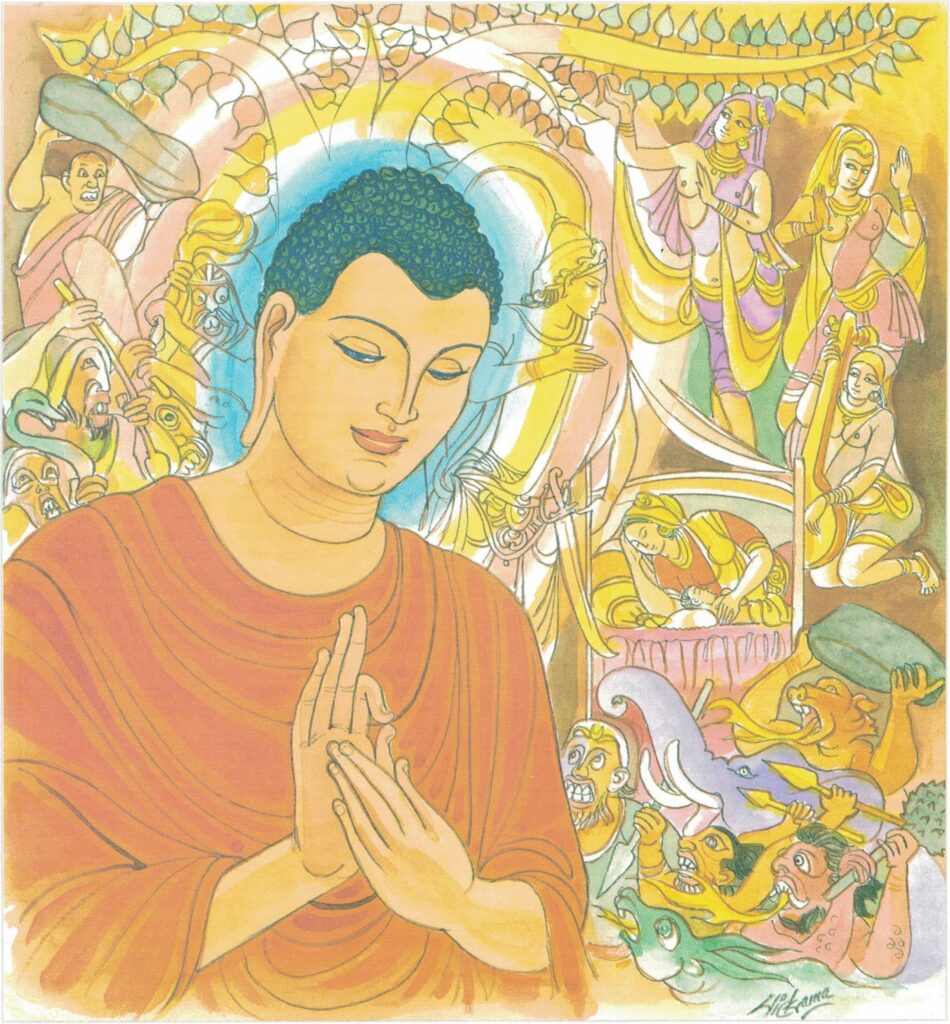Pali text, illustration and English translation of Dhammapada verse 353:
sabbābhibhū sabbavidū’hamasmi sabbesu dhammesu anūpalitto |
sabbañjaho taṇhakkhaye vimutto sayaṃ abhiññāya kam’uddiseyyaṃ || 353 ||
353. Beyond all being, wise to all, unsoiled by dhammas all am I, left all and freed by craving’s end, by self I’ve known, whom teacher call?

The Story of Upaka
The Buddha spoke this verse in answer to the question put up by Upaka, a non-Buddhist ascetic, while He was on His way to the Deer Park (Migadāya) where the group of five monks (panca vaggis) were staying. The Buddha was going there to expound the Dhammacakkappavattana Sutta to the panca vaggis, his old associates, viz., Kondanna, Bhaddiya, Vappa, Assaji, and Mahānāma. When Upaka saw the Buddha, he was very much impressed by His radiant countenance and so said to him, “Friend, you look so serene and pure; may I know who your teacher is?” To him, the Buddha replied that he had no teacher.
At the end of the discourse, Upaka expressed neither approval nor disapproval but just nodded a few times and went on his way.
Explanatory Translation (Verse 353)
ahaṃ sabbābhibhū asmi sabbavidū sabbesu dhammesu anūpalitto
sabbañ jaho taṇhakkhaye vimutto sayaṃ abhiññāya kam uddiseyyaṃ
ahaṃ: I am; sabbābhibhū: one who has overcome all dhammas of the three planes (of existence); asmi: I am; sabbavidū: all knowing; sabbesu dhammesu: in all matters; na ūpalitto [ūpalitta]: not attached; sabbañ jaho [sabbañ jaha]: given up everything; taṇhakkhaye: in the state of cravinglessness (Nibbāna); vimutto [vimutta]: I have achieved freedom; sayaṃ [saya]: by myself; abhiññāya: knowing absolutely well; kam: whom; uddiseyyaṃ [uddiseyya]: can I call my teacher
I have overcome all, I know all, I am detached from all, I have given up all; I am liberated from moral defilements having eradicated craving, (i.e., I have attained arahatship). Having comprehended the four noble truths by myself, whom should I point out as my teacher?
Commentary and exegetical material (Verse 353)
sabbābhibhū: The Buddha described himself as a sabbābhibhū. This expression means one who has overcome all the Dhammas of the three planes of existence.
sabba-vidū: All Dhammas of the four planes of consciousness have been understood. The four planes are: kāma loka (the sphere of sensuality), rūpa loka (the Fine Material Sphere), Arūpa Loka (The Formless Sphere) and Lokuttara (The World-transcending Sphere).
sabbesu dhammesu anūpalitto: untainted with cravings and wrong views in regard to all dhamma of the three planes of existence.
sabbañjaho: having given up all dhammas of the three worlds.
taṇhakkhaye vimutto: liberated by going beyond all cravings.
sayaṃ abhiññāya: having realized the higher knowledge entirely by myself.
After stating all these, the Buddha asks the question, “If I have achieved all these entirely through self-effort, whom shall I point to as my teacher (kam uddiseyyaṃ)?” The implication is that there is no one who could be described as his teacher.
Since the Buddha had no teacher, but became enlightened by Himself, He had initial doubts about others being able to fathom what he realized. This is embodied in:
This, that through many toils I have won,
Enough, why should I make it known?
By folk with lust and hate consumed,
This truth will not be understood.